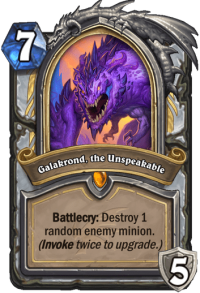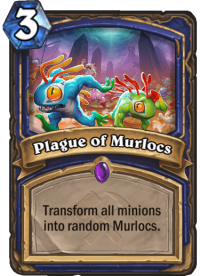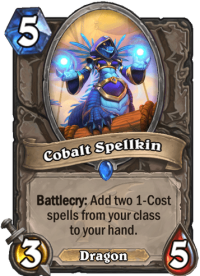We have now had a chance to play the new superpowered Descent of Dragons meta for a couple of weeks, and the first balance patch also arrived already to tone Galakrond Shaman down a notch. There are lots of new decks around, but one archetype has been conspicuously absent in this expansion: control.
Hearthstone is a tempo-oriented game, and many of the design choices promote aggressive playstyles, from the extremely generous mulligan to the attacker’s advantage in choosing targets. Nonetheless, there are usually some control decks in the top tiers, but this time they have been almost completely missing. Only the recent rise of Quest Resurrect Priest has brought control back somewhat, but other than that the meta has been all aggro, tempo, or midrange decks.
I have spent almost all of my playtime this expansion building and playing control decks, and I think there is a lot of potential in them when they are built properly. At the time I’m writing this, the best-performing Quest Resurrect Priest is my list, and I believe there are other great control decks that have not yet been discovered by the masses. In this article, I will discuss what various classes can make happen as control decks and showcase a number of my control decks that I have played this season.
Control Priest
Quest Resurrect Priest is the most hyped control deck at the moment. It can outheal most aggro decks and it can outvalue many slower decks thanks to the power of Activate the Obelisk: any minion that stays on the board after the quest has been completed just keeps growing and becoming more powerful.
My take on the archetype looks like this:
While the deck no longer has access to N'Zoth, The Corruptor, it can still bring its powerful minions back multiple times with Psychopomp, Catrina Muerte, and Mass Resurrection. Coupled with an immense supply of removal tools, Resurrect Priest can be incredibly annoying to play against.
The deck uses only one new card, Breath of the Infinite, but it is a great addition to the archetype, as it gives the deck an early area-of-effect damage ability. Because the deck’s first minions only start coming out at five mana, early removal is crucial to prevent the opponent from snowballing too quickly. My goal with this list has been to focus on the essentials: removal and good minions. I have not included Grave Rune, because it often requires a minion to stick and can be nullified with Silence effects, which are extremely common in the meta thanks to the popularity of Deathrattle Rogue.
Quest Resurrect Priest is one of the strongest control decks right now. I think there is at least one stronger deck out there, but I still lack the stats to prove it.

However, there are more ways to build a Control Priest than just the Quest and Resurrect effects. I am talking about none other than Galakrond, the Unspeakable. Priest’s Galakrond is a control deck dream come true: value, value, and even more value. Yet, statistics seem to show that it sucks.
What the statistics actually show is that all popular Galakrond Priest decks suck, but when you take a look at how they are built that is no surprise. They are simply way too slow for the current meta – a mistake I also made while theorycrafting, but started to correct from day one when the pace of the new meta became clear. I think Priest’s Galakrond is completely fine. It has one major weakness, but that is a weakness most Priest decks share: combo decks. When you try to grind out your opponents, and they can just kill you from full health when they get through their deck, there is not a whole lot you can do. Luckily, combo decks are not very common in the current meta either.
This is what a proper Galakrond Priest deck looks like:
I actually think this list is not yet optimal. In particular, I’m not sure how many Invoke and Invoke synergy cards are really necessary, and how many of them could be replaced with more removal tools. However, the deck captures the essentials of what a successful Galakrond Priest looks like: You only need one win condition, Galakrond. If Galakrond is at the bottom of your deck, that’s going to hurt, but that is why Kronx Dragonhoof is there. In Galakrond Priest, Kronx’s ability to tutor your Galakrond from the deck is more important than the devastation it can unleash when you’re already Galakrond. Even Invoking Galakrond is secondary. Sure, some extra removal is nice, but what you really want is the Hero Power.
Galakrond Priest attempts to remove all threats from the opponent and win through infinite value from the masses of random minions you’re going to get. You can find healing, removal, damage, just anything from Galakrond, and you will get a lot of random minions. Princess Talanji is a huge tempo swing, as she summons all of those random minions from your hand at once.
Quest Resurrect Priest is probably the stronger deck, but Galakrond Priest is a lot of fun to play.
Control Warlock
It is not easy to be a Control Warlock in the current meta. Despite Nether Breath, Warlock still struggles to heal enough, an issue it has suffered from ever since Bloodreaver Gul'dan rotated out of the Standard format. If the opponent has recurring damage, even as simple as the Hunter Hero Power, it is hard to stay afloat.
This does not mean that Control Warlock is unplayable. It is a decent deck, capable of slowly climbing even high ranks, but it is not as effective as a more midrange Handlock can be.
The best part about playing Control Warlock is Twisting Nether. The effect, the animation, the destruction, everything about the card is just so satisfying. Sometimes you can also pretend that you’re a Handlock and go on the offense with Mountain Giants, but the additional removal abilities in the deck mean that you do not have as many threats as a Handlock does. You can come back after losing the board more easily than a Handlock can, but Handlock would strive to not lose the board in the first place and Handlock also has more ways to just end the game.
Control Shaman
Galakrond Shaman has been the center of attention in Descent of Dragons, but Control Shaman still exists. After all, Hagatha the Witch is still here, and while she might not be as fancy as Galakrond, the Tempest, she can outvalue the upstart in a long game.
I think there are multiple ways to successfully build a Control Shaman, but I decided to go the Highlander route for this one:
- 2Acidic Swamp Ooze1

- 2Bloodmage Thalnos1

- 2Doomsayer1

- 2Firetree Witchdoctor1

- 2Zephrys the Great1

- 3Brightwing1

- 3SN1P-SN4P1

- 3Scalerider1

- 4Scaleworm1

- 4Twilight Drake1

- 5Big Ol’ Whelp1

- 5Cobalt Spellkin1

- 5Faceless Corruptor1

- 5Rotten Applebaum1

- 5Zilliax1

- 6Evasive Wyrm1

- 6Khartut Defender1

- 7Crowd Roaster1

- 7Evasive Drakonid1

- 7Siamat1

- 9Dragonqueen Alexstrasza1


Shaman has such a great toolbox for control. Zephrys the Great and Dragonqueen Alexstrasza are great Battlecry minions, and Shudderwock can repeat their Battlecry effects later in the game. Hex and Plague of Murlocs take care of silence and transformation, and the various Dragon synergy cards provide plenty of removal tools. Finally, Hagatha's Scheme and Earthquake provide some major area-of-effect damage.
Were it not for the immense success of Galakrond Shaman, Control Shaman could have received attention much earlier in Descent of Dragons. It is an archetype that has plenty of answers, including multiple tools to transform minions, which can be relevant with the rise of Resurrect Priest.
Control Warrior
The most famous control deck of all time, Control Warrior, has been completely absent from Descent of Dragons. I find this peculiar because I have had a lot of success with multiple varieties of Control Warrior and consider it perhaps the best control deck available in the game.
I have built two main variants of Control Warrior: regular and Highlander. Both are based on Dragon synergies, because there are some great Dragon cards around now that are able to outvalue pure Mech-based approaches to the archetype. Of course, I still use Dr. Boom, Mad Genius – we are talking about a control deck, after all, and Boom still offers unparalleled value.
First, the good old Control Warrior with duplicates:
When building tribal decks, it is important to carefully consider how many tribal synergy cards you need, and which ones are the most beneficial to use. In this deck, I have Deathwing, Mad Aspect – a great board clear by the way – and two copies of each of the best non-Legendary Dragons for Warrior: Emberscale Drake, Cobalt Spellkin, and Dragonmaw Scorcher.

Emberscale Drake is a great minion that provides armor, and altogether the deck has so much armor generation that it can get out of reach of a Holy Wrath Paladin. Cobalt Spellkin is a fabulous value card, and it is at its best in Warrior, a class with lots of great one-mana spells. Dragonmaw Scorcher also shines in Warrior, because Warrior has so many synergies with damaged minions. I have also chosen to add an eight Dragon, but because none of the remaining dragons were that great, I went with Dragon Roar instead for a chance to get duplicates of my good dragons or maybe some class dragons from other classes. Another option would be Dragonqueen Alexstrasza, although she would be a dead card until very late in the game.
Warrior has such an abundance of removal tools available that making the cuts is painful. There are plenty of good cards, so you only want to pick up the very best and not worry about not using everything that is good. For example, with double Spellkins in the deck, I am not running any Shield Slams. I’ll pick up my one-mana spells from the Spellkins. I have received a lot of questions about including this or that, and that just goes to show how many options Warrior has. Anything that has not been included, has been omitted because something else is even better.
This abundance of tools naturally raises the question about going Highlander, and Highlander Control Warrior is, in fact, my favorite control deck in the game at the moment. It looks like this:
- 1Eternium Rover1

- 1Execute1

- 1Shield Slam1

- 1Town Crier1

- 1Whirlwind1

- 2Dragon Roar1

- 2Shield Block1

- 2Warpath1

- 2Weapons Project1

- 3Smolderthorn Lancer1

- 4Molten Breath1

- 4Omega Devastator1

- 4Restless Mummy1

- 4War Master Voone1

- 5Brawl1

- 5Emberscale Drake1

- 5Plague of Wrath1

- 5Supercollider1

- 7Dr. Boom, Mad Genius1

- 8Deathwing, Mad Aspect1

Going Highlander gives you the full benefit of Zephrys the Great and Dragonqueen Alexstrasza, and Warrior does not even have to make many compromises for that, there are just so many cards that can fill similar roles: Execute and Smolderthorn Lancer, for example, one of each is fine. Firetree Witchdoctor did not make the cut for my full control build, but here it can find some missing pieces.
Dragons are the hard part. Of course, the deck uses all the Dragons that the regular version uses and Dragonqueen Alexstrasza on top, but you want to get to at least seven Dragons to ensure enough consistency for your synergy cards. Evasive Drakonid is my current top pick for the seventh slot, but there are multiple options available for that one. For the Highlander build, I have also included War Master Voone, because getting a second copy of Dragonqueen Alexstrasza is just so sweet, and getting second copies of the other dragons can also be useful when there is only one of each in the deck. If you really need a silence effect, teching one in over Voone is an option.
You Can Still Win With Control Decks in Descent of Dragons
Overall, then, I consider control decks to be in a fine position in Descent of Dragons. They will never be the most popular decks in Hearthstone, the odds are stacked against them by design, but by making the right choices to counter the meta, success is still possible. Warrior, Priest, and Shaman all show great promise, and I expect more from the control decks of those classes than what we have seen so far.
There has been only a little development done on control decks in this expansion because midrange decks can have so many powerful win conditions and just go off like fireworks at times, but this can also be viewed as an opportunity: there is a lot of control deck improvement left to do. The decks in this article can hopefully show you some ideas of what can work.
Leave a Reply
You must be logged in to post a comment.


















































Very well written article. Based on my own experience, I definitely agree that some of those decks are underrated by the community. With so much aggro and tempo decks around, slower more controlish decks are not in such a bad spot at all, especially the ones that have some tempo swings available to them (like priest with Talanji or highlander decks with Dragonqueen and Zephrys). That’s the reason why quest resurrect priest is one of the strongest decks at the moment since all those Mass resurrect turns can really swing a game in their favor. Unfortunately, this also means that other control decks have to compete with them. Hence Galakrond priest and control warriors don’t see much play, despite being overall good or even great decks.
I know the latest expansion (within a year) is supposed to be the stongest, but Galakrond is totally dominating the meta. Galakrond decks are more midrange/value which explains why control is absent. I tried a few games playing the traditional control warrior and got wrecked by priest, shaman and even Galakrond warrior, bevause of the Galakrond hero attack power that kept hitting me.
Btw I Just faced quest resurrect priest and dragon control (so people do notice your lists), I wrecked them both with Galakrond shaman 😛 At low ranks (3-1) I’m facing Galakrond warrior, shaman and (highlander) rogue mainly. Face hunter was popular for a while, but I noticed a decline (personal exp) probably because of the bad matchup against Galakrond warrior.
With Galakrond being so OP there’s little room for other deck types. Most games tend to end whoever draws an upgraded Galakrond first (or the dragonqueen) which is sometimes frustrating.